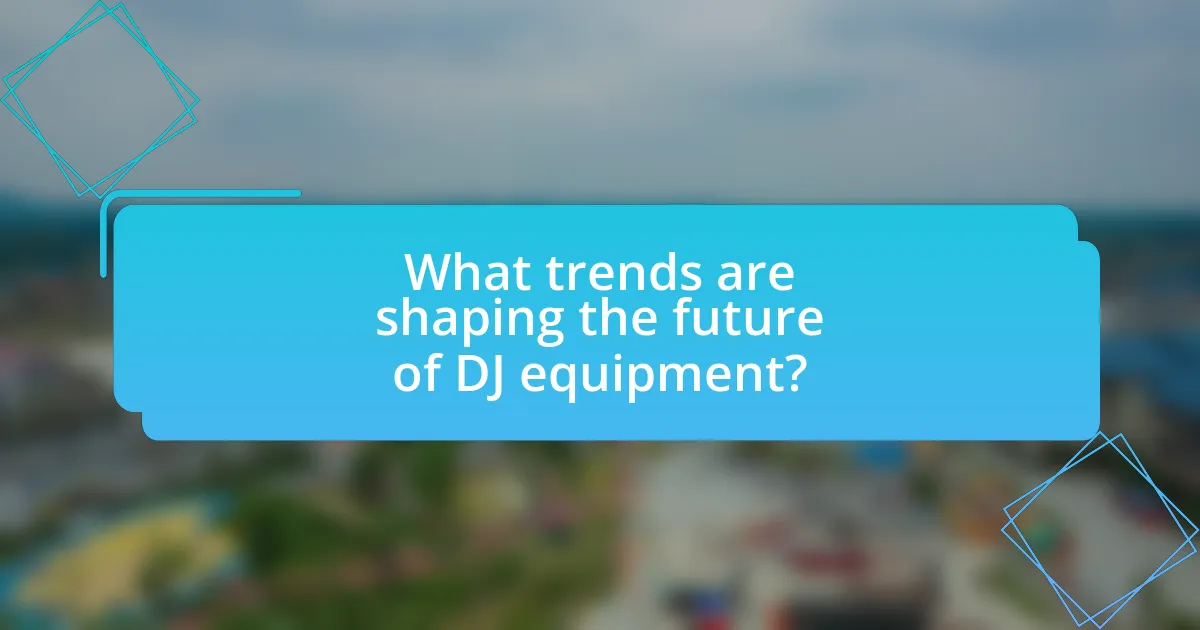The article examines the evolution of DJ equipment, tracing its development from analog turntables to modern digital controllers. It highlights key milestones, including the introduction of vinyl records, CD players, and digital audio workstations, which have transformed DJing practices. The piece also discusses the impact of digital technology on music accessibility and performance capabilities, as well as the advantages of digital formats over traditional methods. Additionally, it addresses emerging trends, such as the integration of artificial intelligence and the influence of streaming services on DJ equipment design and functionality.

What is the Evolution of DJ Equipment?
The evolution of DJ equipment has transitioned from analog turntables to digital controllers, reflecting advancements in technology and changes in music consumption. Initially, DJs used vinyl records and turntables, which allowed for manual mixing and scratching techniques. The introduction of CD players in the 1980s provided a new medium, enabling DJs to access a wider range of music with improved sound quality.
In the late 1990s, digital audio workstations (DAWs) and software like Serato Scratch Live revolutionized DJing by allowing for digital vinyl emulation, where DJs could manipulate digital files as if they were vinyl records. The 2000s saw the rise of MIDI controllers and all-in-one digital DJ systems, which integrated various functions into single devices, enhancing portability and ease of use.
Today, modern DJ equipment includes advanced digital controllers, which offer features such as built-in effects, looping, and seamless integration with music streaming services, allowing DJs to perform with unprecedented flexibility and creativity. This evolution reflects the ongoing adaptation of DJs to technological innovations and changing audience expectations in the music industry.
How did DJ equipment begin its journey?
DJ equipment began its journey with the introduction of turntables in the late 1940s, primarily used by radio DJs to play and mix records. The Technics SL-1200, released in 1972, became a pivotal model that revolutionized DJing by offering direct drive technology, allowing for precise control over playback speed and seamless mixing. This innovation laid the foundation for the development of various DJ tools, including mixers and effects units, which further enhanced the creative possibilities for DJs. The rise of hip-hop culture in the 1980s also contributed to the evolution of DJ equipment, as turntablism emerged as an art form, leading to the creation of specialized gear designed for scratching and live performance.
What were the first tools used by DJs?
The first tools used by DJs were turntables and vinyl records. In the late 1940s and early 1950s, DJs began using these devices to play and mix music at parties and events. The turntable allowed DJs to manipulate the playback speed and direction of the vinyl records, enabling techniques such as beatmatching and scratching, which became foundational to DJing. The use of vinyl records provided a tangible medium for DJs to curate and present their music selections, establishing the groundwork for modern DJ practices.
How did turntables revolutionize DJing?
Turntables revolutionized DJing by introducing the ability to manipulate sound in real-time, allowing DJs to blend tracks seamlessly and create unique mixes. This innovation emerged in the 1970s when DJs began using two turntables to play and mix records, enabling techniques such as beatmatching and scratching. The introduction of direct-drive turntables, like the Technics SL-1200, provided precise control over playback speed and stability, which became essential for live performances. This technological advancement transformed DJing from simple playback to an art form, fostering the development of hip-hop and electronic dance music genres.
What major milestones have shaped DJ equipment?
The major milestones that have shaped DJ equipment include the introduction of the turntable in the 1940s, the development of the mixer in the 1960s, the advent of digital technology in the 1980s, and the rise of digital controllers in the 2000s. The turntable allowed DJs to manipulate sound by playing vinyl records, while mixers enabled the blending of multiple audio sources. The 1980s saw the emergence of digital sampling and the CD player, which expanded the possibilities for DJs. By the 2000s, digital controllers integrated software with hardware, revolutionizing DJing by allowing for more complex performances and easier access to vast music libraries. These milestones collectively transformed the DJing landscape, making it more accessible and versatile.
What innovations emerged in the 1970s and 1980s?
Innovations in the 1970s and 1980s included the development of the first direct-drive turntables, which replaced belt-driven models, allowing for quicker start-up times and more precise control. The introduction of the Technics SL-1200 in 1972 revolutionized DJing by providing a reliable platform for mixing and scratching. Additionally, the emergence of synthesizers and drum machines, such as the Roland TR-808 and TR-909, transformed music production and performance, enabling DJs to create unique sounds and rhythms. The advent of the compact disc in the early 1980s also marked a significant shift in music consumption, leading to the eventual rise of digital DJing. These innovations collectively shaped the landscape of DJ equipment and practices during this era.
How did the introduction of digital technology impact DJing?
The introduction of digital technology significantly transformed DJing by enabling the use of digital audio files and software, which replaced traditional vinyl records and turntables. This shift allowed DJs to access vast libraries of music instantly, facilitating seamless mixing and manipulation of tracks through digital audio workstations (DAWs) and DJ software like Serato and Traktor. Furthermore, digital technology introduced features such as beat matching, looping, and effects processing, enhancing creative possibilities for DJs. According to a report by the International Music Summit, the rise of digital DJing has led to a 70% increase in the use of digital formats in live performances since the early 2000s, underscoring the profound impact of digital technology on the DJing landscape.
What are the key components of traditional DJ equipment?
The key components of traditional DJ equipment include turntables, a mixer, headphones, and speakers. Turntables are used for playing vinyl records, allowing DJs to manipulate sound through techniques like scratching and beatmatching. The mixer serves as the central hub for blending audio from multiple sources, enabling transitions between tracks. Headphones are essential for cueing tracks and ensuring seamless mixing, while speakers amplify the sound for the audience. These components have been foundational in DJing since the 1970s, establishing the framework for live performances and music mixing.
What roles do turntables and mixers play in DJ setups?
Turntables and mixers are essential components in DJ setups, serving distinct yet complementary roles. Turntables are primarily responsible for playing vinyl records, allowing DJs to manipulate sound through techniques like scratching and beatmatching. Mixers, on the other hand, facilitate the blending of audio signals from multiple sources, enabling DJs to transition smoothly between tracks and apply effects. The combination of these two elements allows for creative expression and live performance, which has been a hallmark of DJ culture since the 1970s. Historically, the introduction of the Technics SL-1200 turntable in 1972 revolutionized DJing by providing a reliable platform for mixing, while mixers like the Pioneer DJM series have advanced features that enhance live performance capabilities.
How do vinyl records influence the DJing experience?
Vinyl records significantly influence the DJing experience by providing a tactile and authentic connection to music that digital formats cannot replicate. DJs often prefer vinyl for its unique sound quality, characterized by warmth and depth, which many audiophiles argue is superior to digital audio. Additionally, the physical act of manipulating vinyl records allows DJs to showcase their skills through techniques like scratching and beatmatching, which are integral to live performances. The historical significance of vinyl in the DJ culture, particularly in genres like hip-hop and house music, further enhances its influence, as it represents a foundational element of the art form. This connection to tradition and the physicality of vinyl contribute to a more engaging and immersive experience for both the DJ and the audience.

How has DJ Equipment transitioned to digital formats?
DJ equipment has transitioned to digital formats primarily through the development of digital audio workstations (DAWs), software-based mixing solutions, and digital controllers that emulate traditional turntables. This shift began in the late 1990s and early 2000s, as software like Serato Scratch Live and Traktor allowed DJs to manipulate digital music files with the same techniques used for vinyl records. The introduction of MIDI technology enabled DJs to control software applications with hardware interfaces, further integrating digital formats into live performances. By 2020, over 80% of professional DJs reported using digital formats, highlighting the widespread adoption of this technology in the industry.
What are the defining features of digital DJ controllers?
Digital DJ controllers are characterized by their integration of hardware and software, enabling DJs to manipulate audio tracks seamlessly. Key features include jog wheels for precise track navigation, performance pads for triggering samples and loops, and built-in audio interfaces for direct connection to speakers and headphones. Additionally, many digital DJ controllers offer MIDI compatibility, allowing for customization and integration with various DJ software. The ability to control multiple software functions through physical controls enhances the user experience, making digital DJ controllers versatile tools for live performances.
How do digital controllers compare to traditional turntables?
Digital controllers offer greater versatility and convenience compared to traditional turntables. While turntables rely on vinyl records and mechanical components, digital controllers utilize software and digital files, allowing DJs to access a vast library of music instantly. This shift enables features such as looping, effects, and seamless track transitions, which are more challenging to achieve with turntables. Additionally, digital controllers often include built-in sound cards and MIDI capabilities, enhancing connectivity and integration with other equipment. The transition from analog to digital has been supported by the increasing popularity of digital music formats and DJ software, reflecting a significant evolution in DJ technology.
What advantages do digital formats offer to DJs?
Digital formats offer DJs several advantages, including portability, accessibility, and enhanced functionality. Portability allows DJs to carry vast libraries of music on devices like laptops or USB drives, enabling them to perform anywhere without the physical constraints of vinyl records or CDs. Accessibility is enhanced as digital formats provide instant access to a wide range of tracks, including rare or hard-to-find songs, through various online platforms and streaming services. Additionally, enhanced functionality includes features such as beat matching, looping, and effects that are integrated into digital DJ software, allowing for more creative mixing and seamless transitions. These advantages collectively streamline the DJing process and expand creative possibilities.
What software is commonly used with digital DJ equipment?
Software commonly used with digital DJ equipment includes Serato DJ, Traktor Pro, and Virtual DJ. These applications enable DJs to mix and manipulate music tracks using digital interfaces. Serato DJ is known for its reliability and integration with various hardware, while Traktor Pro offers advanced features for creative mixing. Virtual DJ is popular for its user-friendly interface and extensive compatibility with different controllers. Each of these software options supports a range of audio formats and provides tools for live performance, making them essential for modern DJs.
How do DJ software applications enhance performance?
DJ software applications enhance performance by providing advanced tools for mixing, effects, and track management, which allow DJs to create seamless transitions and unique soundscapes. These applications enable real-time manipulation of audio tracks, offering features like beat matching, looping, and sampling that enhance creativity and precision during live performances. For instance, software such as Serato DJ and Traktor Pro includes features like automatic beat detection and quantization, which help maintain rhythm and timing, crucial for engaging audiences. Additionally, the integration of MIDI controllers with DJ software allows for tactile control over various parameters, further improving the performance experience.
What are the most popular DJ software options available today?
The most popular DJ software options available today include Serato DJ, Traktor Pro, and Rekordbox DJ. Serato DJ is widely recognized for its user-friendly interface and extensive hardware compatibility, making it a favorite among both beginners and professionals. Traktor Pro offers advanced features like remix decks and powerful effects, appealing to creative DJs. Rekordbox DJ, developed by Pioneer, integrates seamlessly with Pioneer hardware and provides robust music management tools, making it a top choice for many club DJs. These software options are frequently updated and supported by a large community, ensuring they remain relevant in the evolving landscape of DJ technology.

What trends are shaping the future of DJ equipment?
The future of DJ equipment is being shaped by trends such as the rise of digital controllers, integration of artificial intelligence, and the increasing popularity of streaming services. Digital controllers are becoming the standard due to their versatility and ease of use, allowing DJs to manipulate music more intuitively. Artificial intelligence is enhancing music selection and mixing capabilities, enabling DJs to create seamless sets with minimal effort. Additionally, the growth of streaming services like Tidal and SoundCloud is influencing equipment design, as DJs seek tools that can easily access vast music libraries. These trends reflect a shift towards more accessible, efficient, and innovative DJing experiences.
How is technology continuing to evolve in DJing?
Technology is evolving in DJing through advancements in digital controllers, software integration, and innovative hardware. Digital controllers now offer features like touch-sensitive jog wheels, built-in effects, and seamless integration with software platforms such as Serato and Traktor, enhancing the DJing experience. Additionally, the rise of cloud-based music libraries allows DJs to access vast catalogs of music from anywhere, facilitating real-time updates and collaboration. Furthermore, developments in artificial intelligence are enabling automated mixing and track selection, streamlining the creative process for DJs. These advancements reflect a significant shift from traditional turntables to sophisticated digital setups, demonstrating the ongoing evolution in the DJing landscape.
What role does artificial intelligence play in modern DJ equipment?
Artificial intelligence enhances modern DJ equipment by automating tasks such as beat matching, track selection, and mixing. This technology analyzes music characteristics, enabling DJs to create seamless transitions and discover tracks that complement each other based on tempo, key, and energy levels. For instance, AI-driven software like Algoriddim’s djay utilizes machine learning algorithms to suggest songs and automate mixing processes, allowing DJs to focus more on creativity and performance. This integration of AI not only improves efficiency but also elevates the overall quality of live performances, making it a significant advancement in the evolution of DJ equipment.
How are emerging technologies influencing DJ performances?
Emerging technologies are significantly influencing DJ performances by enabling enhanced creativity and interactivity. Digital audio workstations (DAWs), advanced software, and hardware innovations allow DJs to manipulate sound in real-time, creating unique mixes that were previously impossible. For instance, the integration of MIDI controllers and software like Serato and Traktor has revolutionized how DJs interact with music, allowing for seamless transitions and effects that enhance the overall experience. Additionally, the use of AI-driven tools for music selection and beat matching streamlines the performance process, enabling DJs to focus more on their artistic expression. These advancements not only improve the technical aspects of DJing but also elevate audience engagement through interactive visuals and live remixing capabilities.
What should aspiring DJs consider when choosing equipment?
Aspiring DJs should consider their budget, the type of music they intend to play, and the portability of the equipment when choosing DJ gear. Budget is crucial as it determines the quality and features of the equipment available; for instance, entry-level controllers can range from $100 to $500, while professional setups can exceed $2,000. The type of music influences the choice of equipment; for example, DJs focusing on electronic dance music may prefer digital controllers with built-in effects, while those playing hip-hop might opt for turntables. Portability is also important, especially for mobile DJs, as lightweight and compact gear facilitates easier transport. These considerations ensure that aspiring DJs select equipment that aligns with their specific needs and performance style.
What factors should be prioritized when selecting DJ gear?
When selecting DJ gear, prioritize sound quality, compatibility, and ease of use. Sound quality is crucial as it directly affects the listening experience; high-quality audio equipment ensures clarity and fidelity. Compatibility with existing gear and software is essential to avoid technical issues and facilitate seamless integration. Ease of use is important for performance efficiency, allowing DJs to focus on their craft rather than struggling with complex equipment. These factors collectively enhance the overall DJing experience and performance effectiveness.
How can DJs effectively transition from turntables to digital controllers?
DJs can effectively transition from turntables to digital controllers by familiarizing themselves with the software and hardware features of digital systems while practicing their mixing techniques. This involves learning the layout and functionality of digital controllers, such as jog wheels, pads, and effects, which differ from traditional turntables. Additionally, DJs should explore digital audio formats and understand how to manage music libraries within software like Serato or Traktor. Research indicates that hands-on practice with digital equipment enhances skill transfer, allowing DJs to maintain their unique style while adapting to new technology.
What are some best practices for maintaining DJ equipment?
To maintain DJ equipment effectively, regularly clean and inspect all components, including mixers, turntables, and controllers. Cleaning should involve using appropriate cleaning solutions for surfaces and ensuring that dust and debris are removed from all parts, as accumulated dirt can affect performance and longevity. Additionally, checking cables for wear and tear is crucial, as damaged cables can lead to sound issues or equipment failure. Proper storage in a controlled environment, away from extreme temperatures and humidity, helps prevent damage. Regularly updating software and firmware for digital equipment ensures optimal functionality and security. These practices are supported by industry standards, which emphasize the importance of maintenance for prolonging the lifespan and reliability of DJ gear.
How can DJs ensure the longevity of their gear?
DJs can ensure the longevity of their gear by implementing regular maintenance, proper storage, and careful handling practices. Regular maintenance includes cleaning equipment after each use to prevent dust and grime buildup, which can damage components over time. Proper storage involves keeping gear in a controlled environment, away from extreme temperatures and humidity, which can adversely affect electronic devices. Additionally, careful handling, such as using protective cases during transport and avoiding excessive force on controls, minimizes wear and tear. These practices are supported by industry standards that emphasize the importance of maintenance for electronic equipment longevity, as neglect can lead to costly repairs or replacements.
What common troubleshooting tips should DJs know?
DJs should know to check all connections and cables first when troubleshooting equipment issues. Loose or damaged cables can lead to sound problems or equipment failure, which is a common issue in live settings. Additionally, DJs should ensure that their software and firmware are up to date, as outdated versions can cause compatibility issues and glitches. Regularly testing equipment before a performance can help identify potential problems early, allowing for timely fixes. Lastly, having backup equipment, such as extra cables or a secondary controller, is crucial to mitigate unexpected failures during a gig.

















